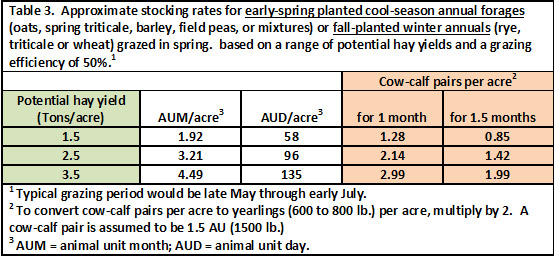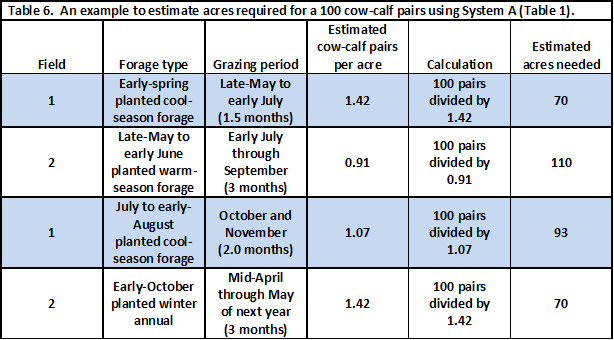Planning Annual Forage Systems
page 3
March 2016
Grazing Efficiency and Grazing Management
Another key factor associated with annual forages is grazing efficiency, which refers to the percent of the forage actually consumed by the grazing animal. With grazing, factors such as stage of growth when grazing starts, grazing or rotation strategy, palatability of the forage, and trampling losses all affect grazing efficiency. In addition, grazing interrupts plant growth which could affect potential forage production. In general, grazing efficiency is lower for the taller growing warm-season annual forages than for cool season species, especially if grazing is occurring when they are relatively mature.
The targeted height to begin grazing depends on the species. For small grains, grazing can begin when they are 6 to 8 inches tall. With sudangrass, grazing can begin at about 18 inches in height. Since sorghum-sudangrass hybrids usually contain prussic acid, grazing should not begin until plants are at least 20 to 24 inches tall. Pearl millet can be grazed when it is 12 to 15 inches tall.
It is a good idea to divide fields into three or more smaller paddocks of a size that permits animals to graze a paddock to the targeted end height within 7 to 10 days. For most warm-season grasses the target residual height to allow good regrowth is 8 inches. For most cool-season small grains, the target residual height is about 4 inches. More information on grazing management of warm-season (summer) annual grasses can be found in NebGuide G2183, Summer Annual Forage Grasses (PDF version, 341KB).
Carrying Capacity and Stocking Rates
Another crucial part of planning annual forage systems is to estimate what the livestock carrying capacity will be. This in turn, will help determine the number of acres of each of the forage types that need to be planted. Production of different annual forages will vary with several factors such as species, growing conditions, planting date, irrigation, and fertilizer management. Spring-planted small grain cereals or winter annuals commonly yield about 2 to 3 tons/acre. Warm-season annuals typically produce 3 to 5 or more tons/acre. Production from mid- to late-summer planted small grain cereal monocultures or mixtures with brassicas can range from 1 to 3 tons/acre with the higher yields related to earlier planting.
Potential hay yield and stocking rates estimates provide starting points for estimating carrying capacity for cool- and warm-season annual forage systems (Tables 3, 4, and 5 - below). Using a planned grazing rotation with several paddocks, a grazing efficiency of 40% for warm-season and 50% for cool-season annual grasses may be attained. Grazing efficiency may be higher during the fall if plants have completed a significant portion of their growth when grazing begins.



To estimate the number of acres needed of each of the forage types for a planned system, divide the total number of head by the carrying capacity estimates. Table 6 provides an example of these calculations following the System A plan illustrated in Table 1 (below).

Page 1 | Page 2 | Page 3 | Page 4 || View all
Jerry D. Volesky
Range and Forage Specialist
Nebraska Extension
Mary E. Drewnoski
Beef Systems Specialist
Nebraska Extension